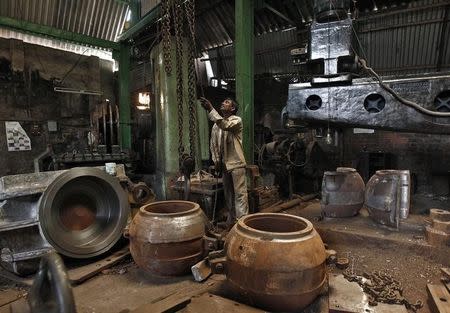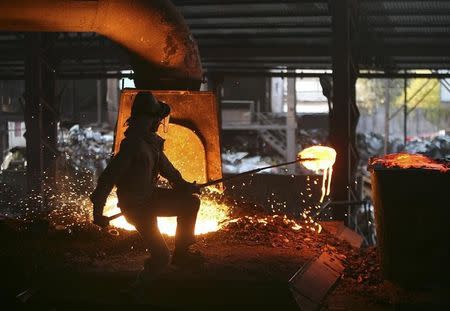Industry data to signal stuttering economic revival
By Rajesh Kumar Singh NEW DELHI (Reuters) - India's industrial output growth likely slowed for a second straight month in July, while inflation probably remained high, with Asia's third-largest economy struggling to make a sustained recovery from its longest stretch of sub-par growth in decades. Output from mines, utilities and factories is forecast to grow 1.8 percent year-on-year, slower than June's 3.4 percent rise, according to a Reuters poll of economists. Output growth had hit a 19-month high of 5.0 percent in May. Retail inflation, which the Reserve Bank of India (RBI) tracks for setting its lending rates, probably edged down marginally to 7.80 percent in August from 7.96 percent a month ago, the poll showed. The numbers come weeks after the economy posted its fastest growth in 2-1/2 years, helped by a revival in industrial activity, prompting Prime Minister Narendra Modi to paint a rosier outlook for coming quarters. However, high inflation would make it tougher for Modi to encourage consumers, who power nearly 60 percent of the economy, to loosen their purse strings. It would also make the central bank wary of lowering interest rates later this month. The RBI, which wants to reduce retail inflation to 6 percent by 2016, left interest rates steady last month, citing inflationary risks from late monsoon rains. While falling global crude prices, moderating vegetable prices, a stable rupee and a favourable statistical base will likely ease inflation, the RBI is widely expected to keep rates on hold when it reviews its monetary policy on Sept. 30. Radhika Rao, an economist at DBS Bank, said the prospect of a revival in demand-driven price pressures following a pick-up in economic activity could ensure a status quo on interest rates at least until end-March. "The RBI is expected to maintain a cautious stance and keep the benchmark rate on hold in 2014/15," she said. Modi won India's strongest electoral mandate in 30 years in May, vowing to lift sliding economic growth, cool inflation and create enough jobs for its young workforce. The optimism fanned by Modi's rise to power has already brought inflows of nearly $14 billion of foreign funds into Indian equities this year as investors bet that his drive to cut red tape would revive stalled projects and underpin the economic recovery. To sustain this euphoria, economists say, Modi must overhaul India's strained public finances, stringent land acquisition laws, chaotic tax regime and rigid labour rules. During his first 100 days in office, the new prime minister showed little appetite for such structural changes, and there is concern that sharply higher growth in the last quarter could obviate the urgency to press ahead with them. "... the pro-business government has facilitated the investment climate and boosted confidence, but more needs to be done to get back to a period of high growth and low inflation," said Rohini Malkani, an analyst at Citi. (Reporting by Rajesh Kumar Singh; Editing by John Chalmers and Simon Cameron-Moore)



